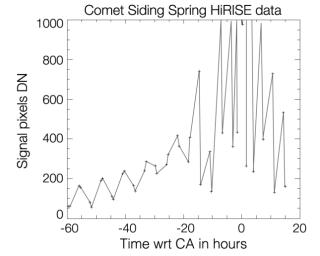
|
Brightness Rhythm of Mars Flyby Comet Is Clue to Rotation Rate
- Click the image above for a larger view
- Full-Res JPEG (973 x 779) (58.1 kB)
- Full-Res TIFF (973 x 779) (759.0 kB)
Caption:
This graph shows changes in apparent brightness of comet C/2013 A1 Siding Spring as it approached and receded from Mars, as seen by the High Resolution Imaging Science Experiment (HiRISE) camera on NASA's Mars Reconnaissance Orbiter.
From the pattern in this graph and other data, researchers conclude that the comet's nucleus rotates once every eight hours. Each peak in apparent brightness corresponds to either a specific area on the nucleus of the comet or a bright jet of material escaping from the nucleus.
The data come from 54 HiRISE observations, beginning 60 hours before the comet's closest approach to Mars on Oct. 19, 2014, and continuing until 15 hour after closest approach. The eight-hour cycle is overlaid on a pattern of apparent brightness increasing as the comet approached, and then dimming as it receded.
Background Info:
For more information on these and other HiRISE images, see http://hirise.lpl.arizona.edu .
HiRISE is one of six instruments on NASA's Mars Reconnaissance Orbiter. The University of Arizona, Tucson, operates HiRISE, which was built by Ball Aerospace & Technologies Corp., Boulder, Colorado. JPL, a division of the California Institute of Technology in Pasadena, manages the Mars Reconnaissance Orbiter Project for NASA's Science Mission Directorate, Washington.
Cataloging Keywords:
| Name | Value | Additional Values |
|---|---|---|
| Target | Mars | C/2013 A1 (Siding Spring) |
| System | ||
| Target Type | Planet | Comet |
| Mission | Mars Reconnaissance Orbiter (MRO) | |
| Instrument Host | Mars Reconnaissance Orbiter | |
| Host Type | Orbiter | |
| Instrument | High Resolution Imaging Science Experiment (HiRISE) | |
| Detector | ||
| Extra Keywords | Color, Rotation | |
| Acquisition Date | ||
| Release Date | 2014-11-07 | |
| Date in Caption | 2014-10-19 | |
| Image Credit | NASA/JPL-Caltech/University of Arizona | |
| Source | photojournal.jpl.nasa.gov/catalog/PIA18862 | |
| Identifier | PIA18862 | |
